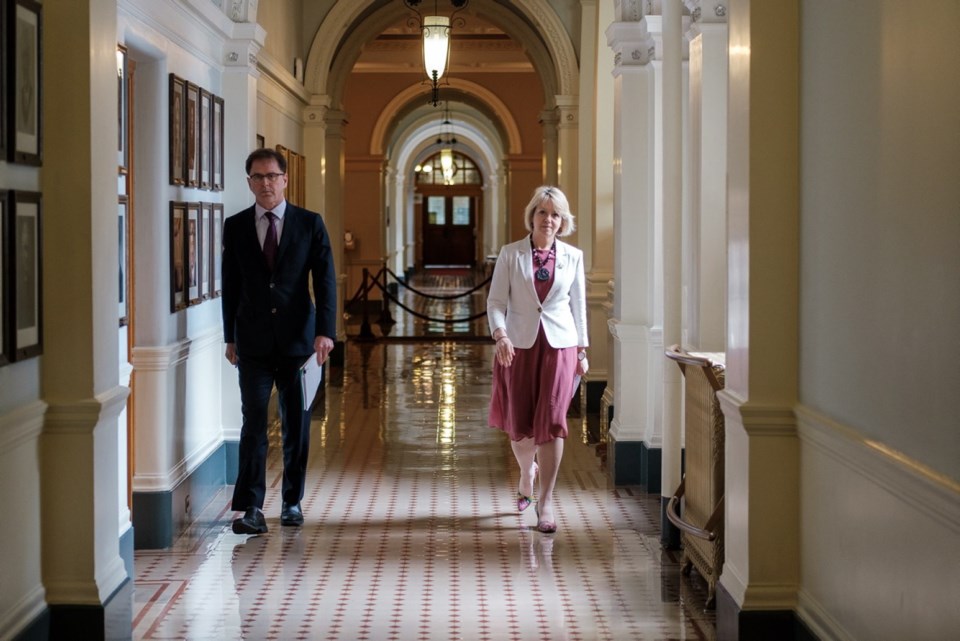Scheduled visits to long-term care homes free of COVID-19 outbreaks will begin in July, says B.C.’s provincial health officer.
“We are going to start slowly and as things will progress, we will expand these activities, as we have done with every other activity,” Dr. Bonnie Henry said Tuesday. “We will be monitoring this on an ongoing basis to ensure that we can expand access as soon as it’s safe to do so.”
Provincewide guidelines are in place. Residents will be allowed to have a single designated visitor who is booked in advance. The visitor must bring and wear a mask. They will be screened for COVID-19 symptoms.
Each care home must have and submit a safety plan. Where a visit is held will depend on the configuration of the care home and the resident, but it could be in a resident’s room, in a common area or outside in a courtyard.
“There have been many dark and anxious days,” Henry said. “But today is a brighter day for us all.”
Isobel Mackenzie, B.C.’s seniors advocate, called the expanded visits a good step in the right direction.
“I think it’s very good news for families, a cautious plan balancing the very clear need for seniors to reconnect with loved ones and one that addresses concerns about exposure to COVID-19,” she said.
It may be difficult at first for care homes to meet the “pent-up demand” for visits, but Mackenzie suggested that a “natural rhythm” will develop over the next month.
Delores Broten, whose husband, Don Malcolm, lives at Comox Valley Seniors Village, welcomed the changes, but said they are still restricted.
“The emotional relief of allowing these visits is enormous, and long, long overdue, although it is very restricted — not the same as popping in to see if someone is OK randomly,” she said. She went three months without seeing Malcolm, 86, before having a 30-minute in-person visit with him in early June.
Broten said the changes announced Tuesday do not address the need for family to independently monitor and help with their loved one’s care.
“It still doesn’t let me go in and feed him and observe what he is really feeling day to day so I can make better decisions about his care,” she said. “Visits are critical, but it is that day-to-day observation which is the real safeguard.”
Henry said we are not at that point yet.
With more than 32,000 residents in long-term care and assisted living, Tuesday’s announcement could mean another 32,000 people being introduced into seniors care homes.
The visits will be reviewed monthly by the province, care homes and health authorities with an eye to expanding visitation if and when it appears safe to do. However, restrictions are expected to be in place in some form for a year.
Health Minister Adrian Dix said the province will provide $160 million for 680 long-term care and assisted-living facilities to hire extra workers to help facilitate visitations. There will also be $26.5 million for costs incurred by seniors homes between March 31 and June 30 for things like extra screening and sick time.
The funding is on top of the $10 million provided to public and private care homes for infection-control measures such as extra testing for respiratory illnesses, added pandemic controls, and increased sterilization.
The province is already spending between $10 million and $15 million a month on its single-site plan which saw workers at 501 senior care homes moved to staffing a single long-term care or assisted-living site to prevent possible spread of the virus.
Restrictions on visits to care homes were put in place in mid-March.
Of the 174 deaths attributed to COVID-19 in B.C.,122 have been elderly people in long-term care, assisted-living or hospital, according to the Health Ministry.
The province has testing and contact tracing measures in place but the approach to visitation in care homes must be cautious, Henry stressed.
“We’re at the point where the risk in our communities is very low,” she said. “It’s not zero.”



